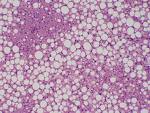A-Drop-In the Obesity Ocean?
Thursday, December 4, 2008BEST HEALTH BLOG FINALIST: The second round of voting is on – please vote AGAIN for your favourite health blog by clicking here
Yesterday, I blogged about NAPEs, which are molecules secreted by the gut that affect food intake. Today, I draw attention to another newly discovered molecule called adropin (encoded by a gene called Enho), which is secreted by the liver in response to a high fat meal (adropin is also expressed in parts of the brain that regulate energy metabolism).
In this study, just out in CELL METABOLISM, Ganesh Kumar and colleagues from the Pennington Biomedical Research Centre (PBRC), Baton Rouge, LA, fed mice with a high-fat diet, resulting in increased secretion of adropin. However, as animals gained weight on the high-fat diet and developed insulin resistance and fatty livers, adropin levels dropped.
Interestingly, in genetically altered mice that expressed high levels of adropin or with administration of exogenous adropin, animals were less likely to develop insulin resistance and fatty livers.
Together, the findings from this study suggest that adropin generation in the liver may play a role in the metabolic adaptation to high dietary fat intake.
Previous studies have shown that obese individuals show impaired metabolic flexibility and do not efficiently match fat oxidation with consumption. If adropin is indeed a metabolic signal to adapt substrate metabolism with fat intake, then the decline in adropin synthesis with obesity may be a factor in the impaired ability to match lipid metabolism with dietary fat intake, leading to the development of fatty livers, dyslipidemia, and glucose intolerance.
Given their findings, the authors conclude that adropin (or its target) may lead to new treatments for obesity-related metabolic disorders.
Obviously, it is still a long way from these findings in mice to treatments that are safe and effective in humans. Nevertheless, this study could be another stepping stone towards better understanding obesity and finding treatments that work.
AMS
Edmonton, Alberta
Hat Tip to Dennis Vance for bringing this study to my attention.



